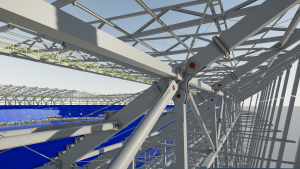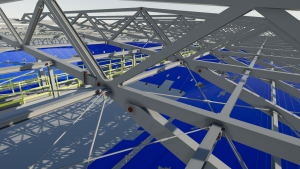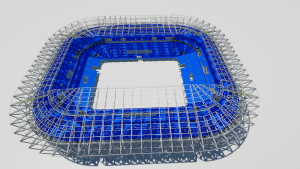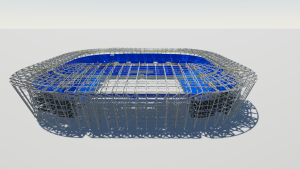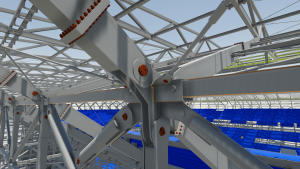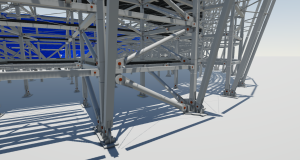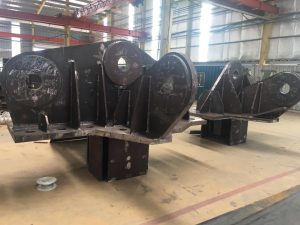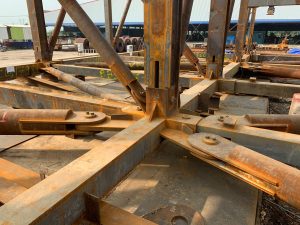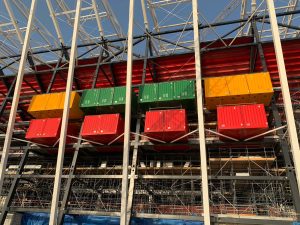Stadion 974 na Mistrzostwa Świata w Katarze
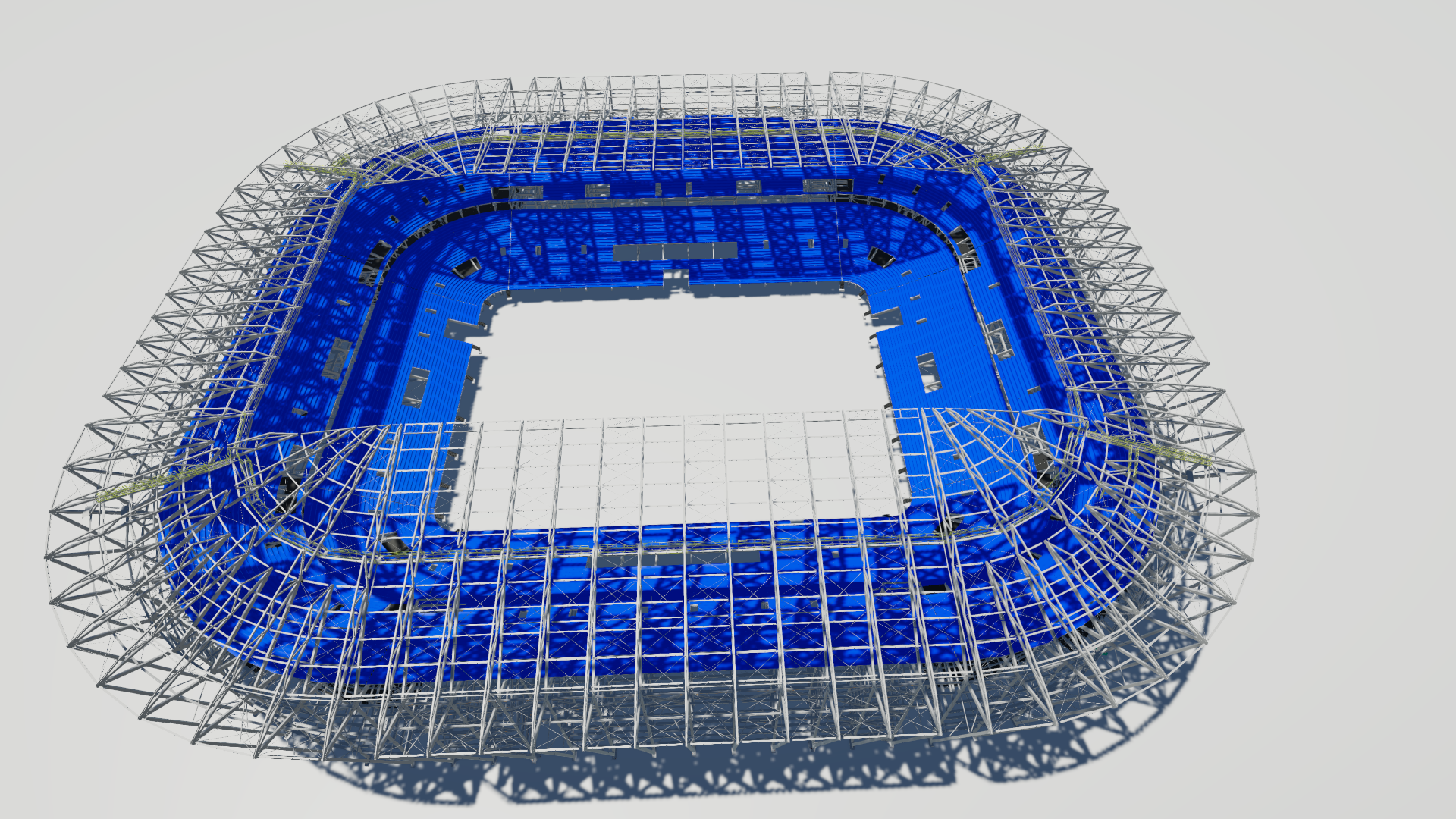
| Categoria | Projectos Desportivos e/ou Recreativos |
|---|---|
| Ano | 2023 |
| País | Poland |
| Organização | MTA Engineering Sp. z o.o. |
| Parceiros do Projeto | Promost Consulting, Neo Spectrum |
| Autor | SBP |
| Co-autores | N/A |
| Cliente | Neo Spectrum Engineering Consultancy |
| Local de construção | Katar |
| Tags |
Stadion 974 w Katarze
Stadion 974 w Doha (w dzielnicy Ras Abu Aboud ) został zaprojektowany na potrzeby organizacji mistrzostw świata w piłce nożnej w 2022r. Stadion zaprojektowany został na 40 tysięcy widzów. Z zewnątrz obiekt sprawia wrażenia zrobionego z gigantycznych kolorowych klocków lego. Efekt ten został osiągnięty dzięki wielkogabarytowym modułowym elementom stalowym i kontenerom, które połączone razem okalają arenę stadionu. Stadion 974, wyznaczając nowe trendy w organizacji światowych imprez sportowych jako pierwszy w historii jest jedynie stadionem tymczasowym i po mistrzostwach ma zostać w całości rozebrany i przeniesiony do innej lokalizacji. Po demontażu obiektu teren, na którym jest on zlokalizowany zamieni się w park o powierzchni ok. 45 hektarów. „Stadium 974” poza spełnieniem restrykcyjnych wymogów FIFA, zaprojektowany został w oparciu o koncepcję zasad zrównoważonego rozwoju w odniesieniu do redukcji emisji dwutlenku węgla. Oznacza to, że projekt tego obiektu został zrealizowany w sposób uwzględniający zarówno jego funkcjonalność, jak i ochronę środowiska.
Nietypowa nazwa stadionu odpowiada numerowi kierunkowemu do Kataru oraz liczbie kontenerów użytych przy budowie obiektu. Przy projektowaniu tego nowoczesnego stadionu zastosowano innowacyjne rozwiązania konstrukcyjne. Stadion zaplanowany do późniejszego demontażu, posiada budowę modularną. Do montażu trybun oraz konstrukcji dachu użyto połączeń sworzniowych. Konstrukcje drugorzędne (klatki schodowe, windy, podesty komunikacyjne) zamontowano przy użyciu połączeń śrubowych.
Technologia BIM umożliwiła koordynację międzybranżową, konsultacje techniczne z projektantami oraz architektami a docelowo wspomagała wielozadaniowo produkcję elementów na warsztacie i planowanie montaży wstępnych. W ramach realizacji istotną część stanowiła odrębna dokumentacja rysunkowa będąca podstawą do weryfikacji obliczeń i dopuszczenia rozwiązań projektowych do produkcji.
Model Tekla w ramach projektu połączył kilka krajów i kontynentów, umożliwił współpracę, wymianę informacji i spełnienie wysokich oczekiwań wielu interesariuszy.
Całkowity tonaż konstrukcji stalowej wyniósł 25 000 ton.
Stadium 974 in Qatar
Stadium 974 in Doha (in the Ras Abu Aboud district ) was designed to host the 2022 World Cup. The stadium is designed to hold 40,000 spectators. From the outside, the facility gives the impression of being made of giant colourful Lego bricks. This effect has been achieved thanks to the large-scale modular steel elements and containers, which are joined together to surround the stadium arena. Setting new trends in the organisation of world sporting events, Stadium 974 is the first ever to be only a temporary stadium and is to be fully disassembled and moved to another location after the championships. Once the facility is disassembled, the area on which it is located will be transformed into a park of approximately 45 hectares. “Stadium 974”, in addition to meeting the strict requirements of FIFA, has been designed based on the concept of sustainability principles with regard to reducing carbon emissions. This means that the design of this facility has been carried out in a way that takes into account both its functionality and environmental protection.
The unique name of the stadium corresponds to the directional number to Qatar and the number of containers used in the construction of the facility. Innovative structural solutions were used in the design of this modern stadium. Planned to be disassembled at a later date, the stadium has a modular structure. Bolt connections were used to assemble the bleachers and roof structure. Secondary structures ( staircases, lifts, communication platforms) were assembled using bolted connections.
BIM technology facilitated interdiscipline coordination, technical consulting with designers and architects, and ultimately supported the multi-tasking of elements in the workshop and the planning of pre-assembly. An important part of the implementation was the separate drawing documentation, which was the basis for the verification of calculations and the release of design solutions for manufacturing.
The Tekla model for the project connected several countries and continents, enabled collaboration, information exchange and met the high expectations of many interested parties.
The total tonnage of the steel structure was 25 000 tonnes.
